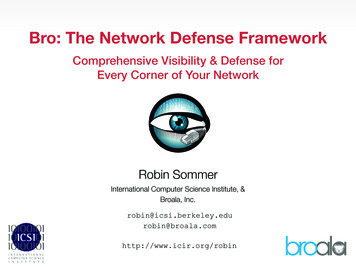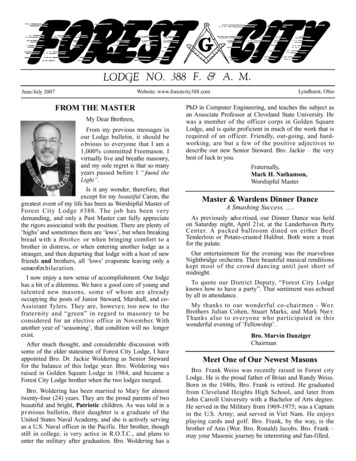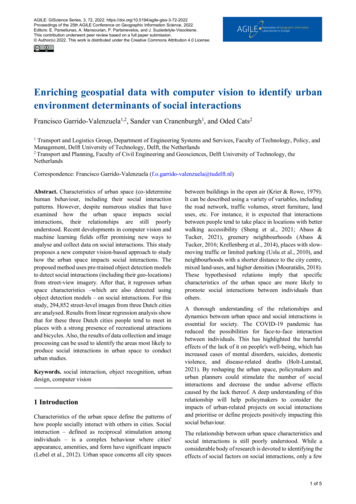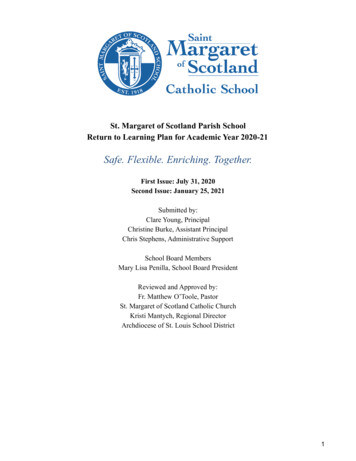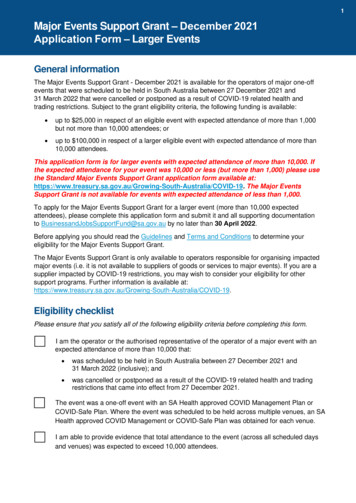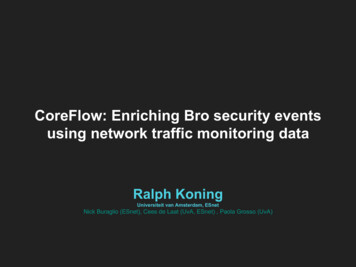
Transcription
CoreFlow: Enriching Bro security eventsusing network traffic monitoring dataRalph KoningUniversiteit van Amsterdam, ESnetNick Buraglio (ESnet), Cees de Laat (UvA, ESnet) , Paola Grosso (UvA)
SARNETSecure Autonomous Response Networks Goal is to build a networks that can autonomouslydefend against cyber attacks. Divided in three parts, Strategic, Tactical, OperationalThe work at ESnetexplores the analyzepart.
CoreFlow motivationTo effectively block attacks, the information from an IDS is not always sufficientWhen an event triggers, the security team has to manually collect additional datafrom different sources to enrich the event to create context andunderstanding of the event.CoreFlow can auto this process by automatically correlating the securityevents to available data sources and provide this context.In this prototype we focus on the following sources: Bro - Generates the events NetFlow - To add network traffic information Route Explorer - To assist in determining paths
BroBro is an Intrusion Detection System that relies on DeepPacket Inspection. Scalable by clustering Bro outputs events in multiple log files: Per protocol x509, ssh, ftp, http, sip, Connection log, contains flow data that the detector sees Notice logs, security alerts that require attention or processing Unique identifier per alert based on alert characteristics Used to lookup more information from other filesBro at ESnet:
NetflowNetflow is a protocol to export statistical flow datafrom network devices to collectors.http://www.nats.aeroNetflow contains information that is not available in BroA flow is a set of packets between one source and destination within a certain timeFlow (source IP, source port, destination IP, destination port, protocol)Netflow at ESnet: collected collected on routers in ESnet (53 sources) 10GB of data for all routers in ESnet per day Samplerate: 1:1000 packets Accessed using NFS
CorrelationWhy? Bro provides information on the content of the event and basic trafficinformation from a fixed viewpoint in the network. Netflow is collected on all the routers in the network and includes more trafficspecific information (which is not available in bro) such as: Router, interface,VLAN, MPLS label, TOSHow?Correlate on common information that is available in both data sources:(source IP, source port, destination IP, destination port, protocol)When there is no matching data in the other data source the events are stillsent out but are not enriched.
CoreFlowCoreFLow correlates events from Bro with Netflow data (and in the futuremaybe other sources).Accepts input from: File (bro log files) Elasticsearch imported flow data STDIN bro log data SplunkEnrichment with data from: netflow (elasticsearch or nfdump) packet designs route explorer (in progress)Outputs to:Written in: Python 3.5 requests, elasticsearch
Approaches that did not workLoading data into memory is a bad idea* The data sets are to big to load into memory Swapping and reading from disk renders systemUnusable.Solution: filter searches for alerts and use iteratorsSearching flow by flow is slow* Batching flows and querying for the whole batch give acceptable speeds This requires an extra step to map the results back to the originating flowImporting and indexing bro conn/netflow data into elasticsearch* Took me a few hours to import bro and netflow data for one hour Streaming information directly into elasticsearch may be better
Current workflowpool Queue(id, flow pair)GuesspossibleroutesMapflows tonetflowQueue(id, netflow data)Queue(id, routes)Queue(id, entialroutesExportResults
CoreFlow Route estimation algorithm It’s able to fill in missing routers Flow traverse a router multiple times (loops) Finds potential ‘shortest paths’r5r1 Topology information from OSCARS Based on latest topology Does not account for policies or metricsr3r2Unorderedroute:Get possibleroutes from r3:ReverseConcatShortestr3, r1, r5r3, r1r3, r5r3, r2r3, r5, r4r3, r2, r4r1, r3r5, r3r2, r3r4, r2, r3r4, r5, r3r1, r3, r1r1, r3, r5r1, r3, r2r1, r3, r2, r4r1, r3, r5, r4 r1, r3, r5r5, r3, r1r4
Route estimation with Route Explorer Appliance sold by Packet Design Route Explorer peers with the routers in a network and stores routinginformation It also records routing changes and historical data Accounts for metrics and routing policies It provides an API that can be used to calculate paths at a point in timeDateThe required ationPrefixthe followingXXXsources:
Conclusions Increasing the sample rate increases the chance of finding an event in theflow data. When flows show up we can, in some cases, estimate the path the maliciousflow took through the network. This allows for filtering traffic at the network entry point Some analysis tools require data that is not available in just one data source;Enrichment can provide the required information for these tools to operate. E.g. Route Explorer
Future work Modularize core Add more information sources: PerfSonar, syslog, etc More advanced alerts Lower threshold for alerts from bro New critical alerts based on enrichedInformation Experiment with different sample rates: 1:1 At the edge?
Thank you!Code available at (private ct:Ralph Koning (UvA / ESnet)rkoning at es.net r.koning at uva.nlhttps://staff.fnwi.uva.nl/r.koning/Nick Buraglio (ESnet)buraglio at -planning/nick-buraglio/
CoreFLow correlates events from Bro with Netflow data (and in the future maybe other sources). Accepts inputfrom: File (bro log files) Elasticsearch imported flow data STDIN bro log data Splunk Enrichmentwith data from: netflow (elasticsearch or nfdump) packet designs route explorer (in progress) Outputsto: Written in: Python 3.5
